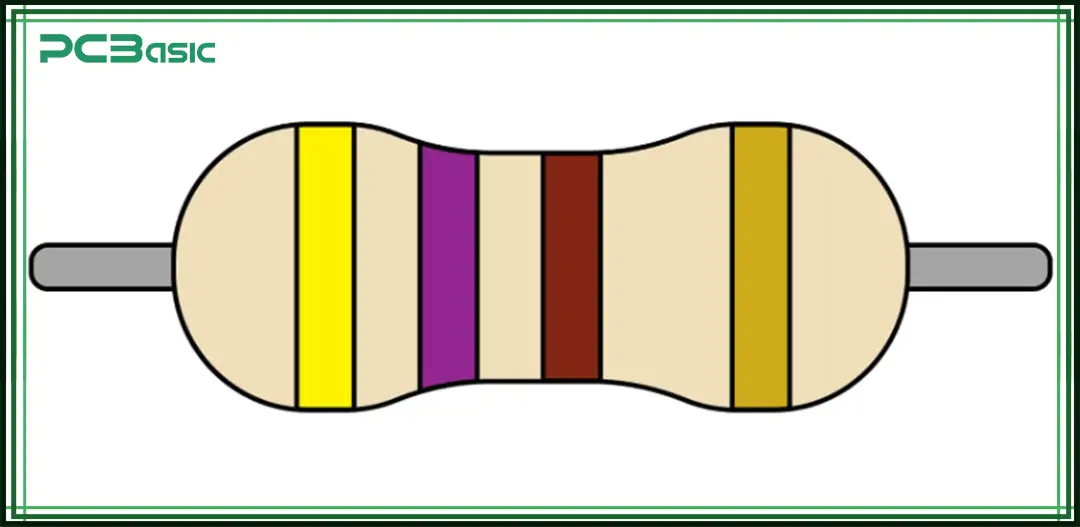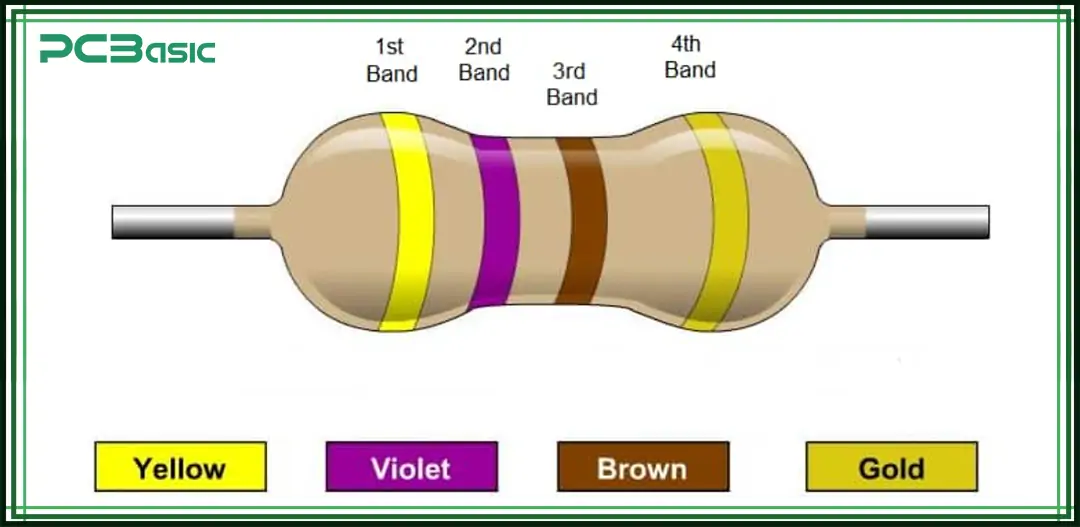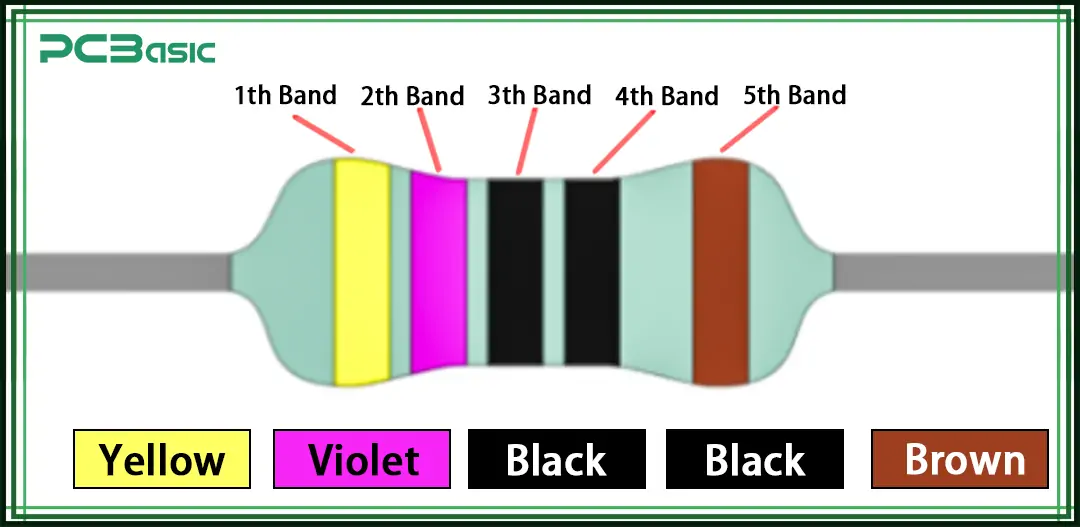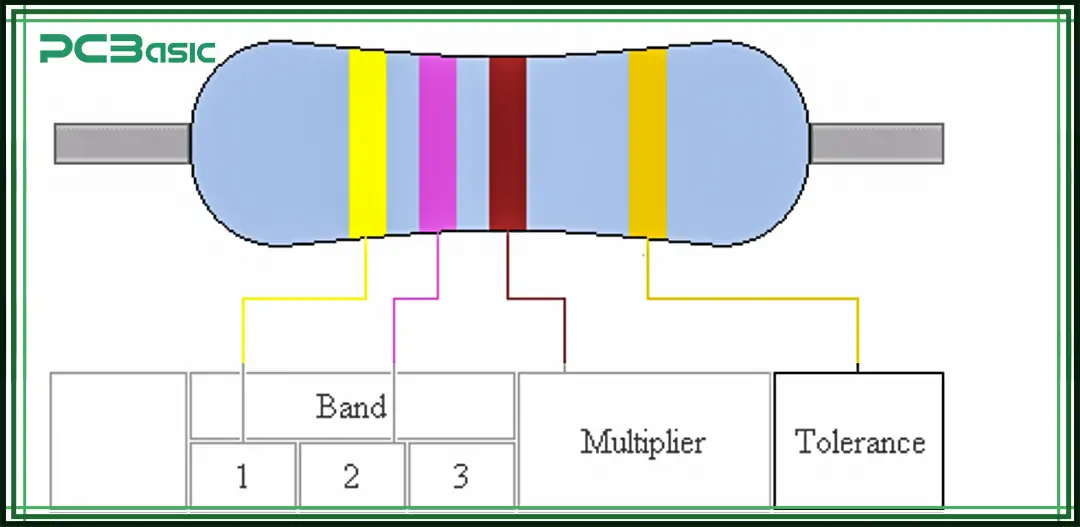

Global high-mix volume high-speed PCBA manufacturer
9:00 -18:00, Mon. - Fri. (GMT+8)
9:00 -12:00, Sat. (GMT+8)
(Except Chinese public holidays)


Global high-mix volume high-speed PCBA manufacturer
9:00 -18:00, Mon. - Fri. (GMT+8)
9:00 -12:00, Sat. (GMT+8)
(Except Chinese public holidays)
HomePage > Blog > Knowledge Base > 470 Ohm Resistor Color Code: A Detailed Guide
In electronics, resistors are the fundamental components that control the flow of current. To use them correctly, one must learn to understand the resistor color code. This system represents the resistor value through the colored bands on the resistor body and does not require measuring tools.
This guide mainly explains the 470 ohm resistor color code. You will learn how to read resistors, how to use a resistor color code chart, and how to tell the difference between a 4-band resistor color code and a 5-band resistor color code.

A resistor is a common passive electronic component. Its function is to limit the flow of current. Simply put, a resistor is like a valve in a water pipe, which is used to control how fast the current flows.
Each resistor has a specific value that is called the resistor value, with the unit being ohm (Ω). The higher the resistor value is, the more difficult the current is to pass through. The lower the value, the easier the current passes through.
Choosing the wrong resistor value may cause serious problems. For instance, the circuit might overheat, components might be damaged, and the entire system might even fail to function properly.
Therefore, it is very important to correctly identify the resistor value. Especially for common components like a 470 ohm resistor, it is necessary to be able to quickly determine its value. This requires you to master the identification method of the resistor color code and learn to understand the colored bands on the resistor.
There are generally two types of 470 ohm resistor color codes: the 4-band resistor color code and the 5-band resistor color code. They can all represent the value of 470 ohms, but the format and precision are slightly different.
The most common type is the 4-band resistor color code, which is usually composed of the following colors:

• Yellow = 4
• Violet = 7
• Brown = ×10 (multiplier)
• Gold = ±5% (tolerance)
The calculation is: The first two digits "47" multiplied by 10, which equals 470 ohms.
The fourth band is the tolerance, which indicates the range within which the actual resistor value may vary by ±5%.
In applications that require higher precision, a 5-band resistor color code will be used. The colors are as follows:

• Violet = 7
• Black = 0
• Black = ×1 (multiplier)
• Brown = ±1% (tolerance)
This calculation is: the first three digits "470" multiplied by 1, which also equals 470 ohms.
However, the tolerance is ±1%, which is more accurate than a 4-band resistor.
In practical applications, a 470 ohm resistor is a very common resistor value. There are several very practical reasons why it is widely used:
1. Highly Versatile
A 470 ohm resistor can be used in many types of circuits. It is applicable to analog circuits as well as digital circuits. Whether it is signal control, level shifting or basic current limiting, it can handle them all.
2. Common for LED Current Limiting
When using LEDs, the current must be controlled; otherwise, the LEDs are very likely to be damaged. A 470 ohm resistor is often connected in series in front with an LED to limit the current. Its resistor value is ideal for LED current-limiting applications in most 5V and 3.3V systems.
3. Useful in Voltage Divider Networks
Voltage dividers are circuits that divide voltage into smaller parts. The 470 ohm resistors are often used together with other resistors to form a voltage divider network for sampling, feedback or signal conversion.
4. Part of the E12 Standard Series
In electronic engineering, a set of standard resistor value series is commonly used, known as the E12 series. The design purpose of this series is to provide evenly spaced values per decade. 470Ω is a standard value in the E12 series, which means it is not only easy to purchase but also convenient for designers to design with.
It is precisely for these reasons that 470 ohm resistors are widely used in various electronic projects such as development boards, prototype circuits, and embedded systems. Whether it is for learning, testing, or production, a 470 ohm resistor is almost one of the essential basic components.
 About PCBasic
About PCBasic
Time is money in your projects – and PCBasic gets it. PCBasic is a PCB assembly company that delivers fast, flawless results every time. Our comprehensive PCB assembly services include expert engineering support at every step, ensuring top quality in every board. As a leading PCB assembly manufacturer, we provide a one-stop solution that streamlines your supply chain. Partner with our advanced PCB prototype factory for quick turnarounds and superior results you can trust.
To accurately identify the resistor value of a resistor, you must learn how to read the color bands on the resistor. This process is very simple. Just follow the steps below:

Step 1: Determine the Reading Direction
Observe the two ends of the resistor. Usually, the side where the color bands are closer to the edge is usually the starting point. Start reading from that side.
Step 2: Refer to the Resistor Color Code Chart
Each color band represents a specific number or multiple. You can use a standard resistor color code chart to match the colors with their numerical values.
Step 3: Calculate the Value Based on the Number of Bands
• For a 4-band resistor:
The first two bands represent two digits
The third band is the multiplier
The fourth band is the tolerance
• For a 5-band resistor:
The first three bands represent three digits
The fourth band is the multiplier
The fifth band is the tolerance
Example: 470 Ohm Resistor (4-Band)
Let’s say you see a resistor with the following color bands:
• Yellow = 4
• Violet = 7
• Brown = ×10 (multiplier)
• Gold = ±5% (tolerance)
Calculation:
The first two digits “47” multiplied by 10 gives 470 ohms, with a tolerance of ±5%.
Final result: 470 ohms ±5%
Mastering the above steps, you can quickly determine the value of any resistor. This is the basic skill that must be mastered when learning electronic technology. Correctly understanding how to read resistors and use the resistor color code chart can help you avoid connecting incorrect components and ensure the stable operation of the circuit.
The resistance color code chart is the most important reference tool for decoding resistor bands. The following is the simplified version of the comparison table:
|
Color |
Digit |
Multiplier |
Tolerance |
|
Black |
0 |
×1 |
— |
|
Brown |
1 |
×10 |
±1% |
|
Red |
2 |
×100 |
±2% |
|
Orange |
3 |
×1,000 |
— |
|
Yellow |
4 |
×10,000 |
— |
|
Green |
5 |
×100,000 |
±0.5% |
|
Blue |
6 |
×1,000,000 |
±0.25% |
|
Violet |
7 |
×10,000,000 |
±0.1% |
|
Gray |
8 |
×100,000,000 |
±0.05% |
|
White |
9 |
×1,000,000,000 |
— |
|
Gold |
— |
×0.1 |
±5% |
|
Silver |
— |
×0.01 |
±10% |
This resistor color code chart helps when identifying any value, not just the 470 ohm resistor.
Although resistor color coding reading seems simple, in actual practice, especially for beginners, some common mistakes often occur. These errors may cause you to misread the resistor value, thereby affecting the performance of the entire circuit. The following are some common problems and corresponding suggestions:
1. Incorrect Reading Direction
The color bands on the resistor have a specific reading direction. If you start reading from the wrong end, the calculated resistor value will be completely incorrect. The correct method is to start reading from the side of the color bands closer to the edge. This side is usually also the one with denser colors and tighter arrangements.
2. Confusing Similar Colors
Some colors can be easily confused during observation, especially in dim light or when the resistor is faded. Red, orange and brown are the easiest to misread. It is recommended to use a resistor color code chart as a reference, and a magnifying glass if necessary.
3. Ignoring the Tolerance Band
Many people only focus on the first three or four colors and ignore the last color band representing tolerance. However, tolerance represents the allowable error range of resistance, which is particularly important in circuits with high precision requirements. When reading, be sure to include this color and do not omit it.
4. Assuming All Resistors Use 4-bands
Not all resistors use a 4-band resistor color code. Nowadays, many precision resistors use the 5-band resistor color code. So before reading, it is essential to count the number of color bands first and then decide which reading rule to follow.
Learning to identify the resistor color code is a fundamental skill that every electronic engineer, enthusiast and student must master. This ability is very important both in classroom learning and in actual projects.
Starting from identifying the common 470 ohm resistor color code to understanding the difference between the 4 and the 5-band resistor color code, this knowledge can help you determine the resistor value more accurately, thereby ensuring the safe, stable, and reliable operation of the circuit.

Assembly Enquiry
Instant Quote
Phone contact

+86-755-27218592
In addition, we've prepared a Help Center. We recommend checking it before reaching out, as your question and its answer may already be clearly explained there.
Wechat Support

In addition, we've prepared a Help Center. We recommend checking it before reaching out, as your question and its answer may already be clearly explained there.
WhatsApp Support

In addition, we've prepared a Help Center. We recommend checking it before reaching out, as your question and its answer may already be clearly explained there.
